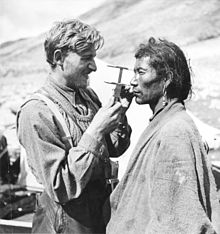German Tibet expedition Ernst Schäfer

The German Tibet Expedition Ernst Schäfer (1938/39) was an expedition to central Tibet led by the German zoologist Ernst Schäfer and supported by the SS organization Ahnenerbe and by Heinrich Himmler . The objectives of the company belonged to the search for cold-resistant grains and a robust horse race for the German war economy as well as evidence for the hypothesis in the seclusion of the Himalayas are remains were originally Aryan receive populations.
History and documentation
In April 1938, shepherds and four companions set out from Genoa for the Himalayas. At the beginning of 1939, they were the first Germans to reach the "forbidden city" of Lhasa , where they stayed for two months and made their first diplomatic contacts between the German Empire and Tibet . In the further course of the expedition with a six-month stay in Sikkim , they documented the flora and fauna of the Himalayas and collected materials and data on the Tibetan population. The anthropologist Bruno Beger , who was assigned to the expedition by the SS Race and Settlement Office, measured the skulls of members of various peoples in Tibet for his racial research and hoped to find clues to the origins of the "Aryan race" in this way.
After his return in August 1939, Schäfer published a series of articles, most of them focusing on regional studies. The focus of the scientific reporting on the expedition was the supposed discovery of the well-known so-called " Schapi " ( Hemitragus Jemlahicus ), while the anthropometric investigations took a back seat .
The materials brought from Tibet by the expedition participants were examined in the specially established " Research Center for Inner Asia and Expeditions in the Ahnenerbe of the SS ". This was also the planning office for a commando company that was never realized , with which the experiences of the Tibet expedition were to be used militarily for a strike against the British in India .
The film Secret Tibet , which premiered in 1943, was made on the basis of the extensive footage of the expedition . In the documentation classified by the Reich Ministry for Public Enlightenment and Propaganda as “youthful and politically, culturally and artistically valuable”, the expedition was presented as a prime example of National Socialist scientific work. The film was enthusiastically received by the audience and thus contributed “to the conscious politicization of the German population through the illustration of the German fighting spirit in the aesthetic and impressive mountains of the highest mountains in the world” (Mierau).
A statue made of metal from the Chinga meteorite was assigned to the historical artifacts brought by the popular media in 2012 . However, there are serious doubts that this statue was actually brought to Germany by Ernst Schäfer, who carefully documented everything during his expedition. "There is a very precise list with the date, place and value of the purchased objects" explained the historian Isrun Engelhardt, who dealt intensively with the Schäfer expedition. Some statues are included in this list, but none of the descriptions match the Buddha statue mentioned above. Furthermore, various features of the statue, such as the shape of trousers and shoes, the individual earring and the man's beard, are atypical. Experts suspect it was formed between 1910 and 1970.
literature
- Peter Mierau: National Socialist Expedition Policy. German expeditions to Asia 1933–1945. Utz, Munich 2006, ISBN 3-8316-0409-6 , ( Munich contributions to historical studies 1), (also: Munich, Univ., Diss., 2003), ( reading sample , Utzverlag, pdf (various chapters); Karsten Jedlitschka : Review . In: H-Soz-u-Kult from December 14, 2006).
- Wolfgang Kaufmann: The Third Reich and Tibet. The home of the "Eastern Swastika" in the Nazis' field of vision . 2nd, corrected and supplemented edition. Ludwigsfelder Verlagshaus, Ludwigsfelde 2010, ISBN 978-3-933022-58-5 (with a detailed description of the expedition and the processes before and after)
- Peter Meier-Hüsing: Nazis in Tibet - The riddle of the SS expedition Ernst Schäfer , Theiss 2017, ISBN 978-3806234381
Web links
- Christopher Peter and Jürgen Ritter: “ Nazis on the Roof of the World ”, in: one day . Contemporary stories on Spiegel Online.
- Isrun Engelhardt: " The Ernst Schäfer Tibet Expedition 1938–1939 "
- Isrun Engelhardt: " Tibet and National Socialism: Facts and Fictions "
- StudyBuddhism.com: The Nazis' Relationship with Shambala and Tibet
- Secret Tibet, description of the film
Individual evidence
- ↑ Historic photographs of Sikkim. 'Who is behind the camera?' Namgyal Institute of Tibetology (Deorali, Gangtok), archived from the original on August 7, 2008 ; accessed on February 5, 2009 .
- ↑ Film overview of the film archive in the Federal Archives , magazine number 10212, entry number BMI 1033, here quoted from Mierau, National Socialist Expeditionspolitik , p. 433.
- ^ Mierau, National Socialist Expedition Policy , p. 523.
- ↑ Achim Bayer: The Lama Wearing Trousers: Notes on an Iron Statue in a German Private Collection (PDF; 1.75 MB). Center for Buddhist Studies, Hamburg 2012 (English).
- ↑ Isrun Engelhardt: Nazi find from Tibet: At the beard of the Nazi Buddhas . Spiegel Online, October 22, 2012, accessed October 24, 2012.

